![]()
![]()
![]()
Use LEFT and RIGHT arrow keys to navigate between flashcards;
Use UP and DOWN arrow keys to flip the card;
H to show hint;
A reads text to speech;
29 Cards in this Set
- Front
- Back
|
Function of the membrane
|
The membrane is the boundary between the cell and its environment
• it controls which substances can enter or exit the cell |
|
|
amphipathic
|
a molecule that has both hydrophobic and hydrophilic region
1) Phospholipids 2) Proteins embedded in membrane |
|
|
The fluid mosaic of the cell membrane
|
Fluidity
• The molecules of the membrane drift laterally across the plane • allows the membrane to be permeable Mosaic • appearance created by proteins embedded in membrane |
|
|
What affects the fluidity of the membrane?
3 |
1) Temperature decrease = fluidity decrease
• phospholipids pack closely together (like cold bacon grease) 2) Kinks of unsaturated fatty acids keep membrane liquid at room temp. vs. condensed saturated fats 3) Cholesterol keeps phospholipids further apart preventing solidification and stabilizes it at high temps |
|
|
2 types of proteins in the membrane based on location
|
1) Integral proteins = transmembrane
2) Peripheral = attached to membrane or integral proteins on the cytosolic side |
|
|
Do all the proteins of the membrane move?
|
No. Some are held in place because they are attached to the cytoskeleton or
|
|
|
6 types of proteins based on function
|
1) Transporter
2) Enzyme 3) Cell-surface receptor 4) Cell-to-cell recognition 5) Cell-to-cell adhesion 6) Attachment to the cytoskeleton |
|
|
Transport protein
|
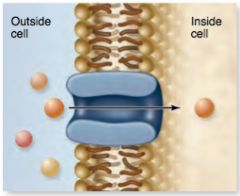
Since the membrane is selectively permeable, molecules that cannot pass through with ease need transport proteins.
2 types: 1) channels 2) carriers composed or proteins |
|
|
Aquaporins
|
Transport proteins that transport water
|
|
|
Enzyme proteins
|
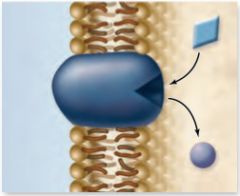
Act as catalysts for chemical reactions
|
|
|
Cell-surface receptor proteins
|
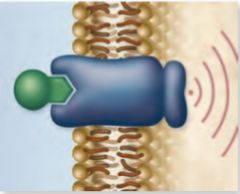
Detect chemical messages
|
|
|
Cell-surface recognition
(identity marker proteins) |

Identify the cell to other cells
|
|
|
Cell-to-cell adhesion proteins
|
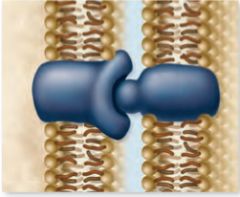
Glue cells to one another temporarily or more permanently
|
|
|
Linking proteins
|
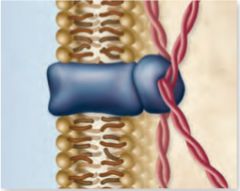
Anchor surface proteins which intereact with other cells to the cytoskeleton
|
|
|
Cell-to-cell recognition
Is important for...2 How do cells recognize one another? |
the ability of a cell to distinguish one cell from another
Important for: 1) building tissues 2) immunity's rejection of foreign cells Glycoproteins: self recognition Glycolipids: tissue recognition |
|
|
Selective permeability of the membrane:
What substance can pass through with ease? Which need assistance? |
Can: Small, non-polar molecules
ex. O2, CO2, steroids Can't: Large ionic or polar molecules ex. sugar, amino acids |
|
|
Diffusion
Passive or active? What causes it? |
• The movement of molecules into available space down the concentration gradient
• Passive transport • heat causes molecules to move |
|
|
Concentration gradient
It stores... |
• High concentration to low concentration
• stores potential energy which is transformed into kinetic energy as molecules moves |
|
|
Passive transport vs. active transport
|
Passive = moving down concentration gradient; requires no energy input
• spontaneous • leads to homeostasis Active = moving against concentration gradient; requires energy (ATP) and a carrier protein • non-spontaneous • ex. sodium-potassium pump |
|
|
Osmosis
|
Water molecule diffusion
|
|
|
Tonicity
|
The ability of a cell to gain or lose water
• if solutes cannot move, water must • water moves towards higher solute concentration - to where there is less water |
|
|
3 tonicities
|
Hypertonic = high solute concentration
Hypotonic = low solute concentration Isotonic = same solute concentration on both sides of membrane |
|
|
In an isotonic solution, does water stop moving?
|
No! It continuously flows in and out of membrane at a constant rate, and so isotonic state does not change
|
|
|
Tonicities of animal cells
If the environment is: |
Hypertonic: cell shrivels
Hypotonic: cell swells and bursts Isotonic: Favorable |
|
|
Tonicities of plant cells
If the environment is: |
Hypertonic: plasmolysis = cell shrivels
Hypotonic: turgid = cell swells FAVORABLE Isotonic: flaccid |
|
|
Facilitated diffusion
|
Movement of molecules from greater to lesser concentration with the help of a transport protein
• molecules would need help if they are polar and/or too large to pass through selectively permeable membrane |
|
|
2 types of transport proteins
|
1) Channel proteins:
• has a polar charged corridor that allows ions and polar molecules to pass through the membrane • down concentration gradient • ex. aquaporins 2) Carrier proteins • binds to solute and carries it to the other side of the membrane • substance can go from lesser to greater concentration |
|
|
Active transport / carrier protein mechanism
Ex. Sodium-Potassium Pump |
1) Permease, a carrier protein, maintains high concentrations of K+ in cell and Na+ out of cell
2) Permease picks up 3 Na+ 3) ATP attaches to permease so it can turn around and release Na+ • when permease is facing out of cell it is in its high energy state 4) Permease picks up 2 K+ 5) ATP releases and permease turns back around to low energy state |
|
|
What is the purpose of active transport?
|
The work of the carrier protein builds a concentration gradient, which store potential energy that can be used to do work
• it charges the cell! |

